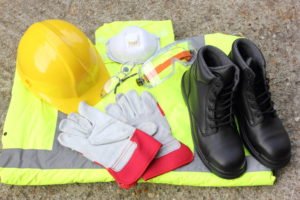Following from her previous article on inclusive PPE, Katherine Evans analyses the PPE supply chain, and questions where the true issue may lie when it comes to accessing diverse PPE.
I constantly hear ‘manufacturers just need to make women’s PPE’, and that statement is starting to grate on me.
 Here are the links in the chain which gets PPE from the manufacturer to the end user;
Here are the links in the chain which gets PPE from the manufacturer to the end user;
- Manufacturer – the company making the PPE;
- Supplier – the stockist of multiple manufacturers and from whom businesses buy their PPE;
- Procurement/ Purchasing Departments – the department or people who choose the supplier to buy from, making them an “approved supplier”
And those people who deal directly with the account holders at the suppliers;
- Line Managers – the people who arrange or sign off the PPE order for their direct reports;
- End User – the people who wear the PPE to do their job safely.
Over the last 12 months I’ve been working on a list of PPE manufacturers who are making decent, inclusive PPE, trialed by myself or members of Bold as Brass, a network I set up for women and their allies in heavy industry.
Yes, there are plenty of manufacturers out there who aren’t quite there yet with great fits or great quality, but with how often I am contacted by manufacturers about trialing PPE or asked for help with what women actually need, I’d say this is not the corner of the industry we need to continue pointing the finger at.
Available stock?
 The supplier is a company that links the manufacturer’s products with businesses and organisations. They stock products for their customers to choose from, so if they only stock one pair of safety boots in a size 3, off a man’s last, then that’s what the end users with size 3 feet can have.
The supplier is a company that links the manufacturer’s products with businesses and organisations. They stock products for their customers to choose from, so if they only stock one pair of safety boots in a size 3, off a man’s last, then that’s what the end users with size 3 feet can have.
If the supplier only stocks “unisex” products, then that is what the procurement departments will be buying if they aren’t dictating to the suppliers what it is their business requires to keep their staff safe. If the account holders at the suppliers are slimming down fully inclusive ranges available to their customers to create the largest profit margins for the suppliers, then that further reduces what is available to the end user.
Procurement departments may then create a list or catalogue of PPE available to the end users in their business – which should be based on the hazard and risk associated with the environments particular end users work in.
But in the worst case, this is based on reducing costs or made by a non-diverse team, never having worked on similar sites, and/or who don’t understand the requirements of the end users.
Another hurdle
 A broken link in the chain is a lazy line manager who can’t be bothered to find out where to get the correctly fitting PPE for their direct report(s), which would be a symptom of their employer not rolling out PPE purchasing process properly, putting people who shouldn’t be managers into management positions, or a mix of the two.
A broken link in the chain is a lazy line manager who can’t be bothered to find out where to get the correctly fitting PPE for their direct report(s), which would be a symptom of their employer not rolling out PPE purchasing process properly, putting people who shouldn’t be managers into management positions, or a mix of the two.
It then falls back onto the individual end user trying their best to find the right thing with naff all information.
This is usually when I hear from people.
Reader, can you see what could go wrong, right here, at this point of the chain?
PPE is not uniform
Additionally, an issue that needs to be overcome to ensure our people are protected is the acceptance of PPE not being a uniform or just clothing. PPE is the final level of the safety system, there to protect the individual carrying out a task.
Do our health and safety people understand the differences between pieces of PPE or are they blanket ruling, regardless of what is available or what individuals need for the uniqueness of their body and health?
Are our procurement departments setting price limits on PPE despite what it costs to fully kit out someone who isn’t the average sized man?
Are suppliers really showing their full range available to procurement departments and businesses?
Is anyone even questioning what the suppliers are able to supply, or their ethics and values, and whether they are the right fit for their business?
Choices
As far as I can tell from working on this in detail over the last year, manufacturers overall are doing a good job, with places for improvement and definite gaps in the market, but this is not the start of the chain of ignorance.
Instead, we can point that finger back at ourselves. Back towards the supplier we are choosing, the purchasing departments we put in place, our line management, and our health and safety departments, because inclusive PPE, for women especially, is available, what’s stopping it reaching end users is completely under our control.
Why should you subscribe to the SHP newsletter?
Do you want the very latest health and safety news, product launches, job listings and expert opinions sent straight to your inbox daily?
The SHP newsletter is essential reading – sign up today to get your hands on all this!

 Here are the links in the chain which gets PPE from the manufacturer to the end user;
Here are the links in the chain which gets PPE from the manufacturer to the end user; The supplier is a company that links the manufacturer’s products with businesses and organisations. They stock products for their customers to choose from, so if they only stock one pair of safety boots in a size 3, off a man’s last, then that’s what the end users with size 3 feet can have.
The supplier is a company that links the manufacturer’s products with businesses and organisations. They stock products for their customers to choose from, so if they only stock one pair of safety boots in a size 3, off a man’s last, then that’s what the end users with size 3 feet can have. A broken link in the chain is a lazy line manager who can’t be bothered to find out where to get the correctly fitting PPE for their direct report(s), which would be a symptom of their employer not rolling out PPE purchasing process properly, putting people who shouldn’t be managers into management positions, or a mix of the two.
A broken link in the chain is a lazy line manager who can’t be bothered to find out where to get the correctly fitting PPE for their direct report(s), which would be a symptom of their employer not rolling out PPE purchasing process properly, putting people who shouldn’t be managers into management positions, or a mix of the two.
Just a shame Personal Protective Equipment PPE was not effectively available until 2018 or 2019, under “Accessibility Regulations” for Display Screen Operators continuing to suffer debilitating over-exposure to sub-optimally calibrated DSE far from “temporary” vision loss actually qualifying them, once diagnosed, for prosthetic compensatory prosthetic PPE DSE Screen Glasses to manage their progressive on-going vision loss. ISO 45001 “Work Exposure Limits” so far has not introduced a “Right to Disconnect” or significantly remove “working-hour waivers” from employment contracts or seen a return to reasonable ergonomic visual and physical breaks away from the operators workstation. Time and motion studies clearly identified… Read more »
There are some very good points here about why workers can end up with unsuitable or inadequate PPE. The way in which PPE is procured also varies widely between employers. In my experience the answer to “Do our health and safety people understand the differences between pieces of PPE?” is very much yes they do, but H&S advisors are often excluded from purchasing decisions, or their advice is filtered and distorted along a long chain of communication and authority. I’m sure many of us have had the frustrating experience of seeing our advice overridden by senior managers who preferred to… Read more »